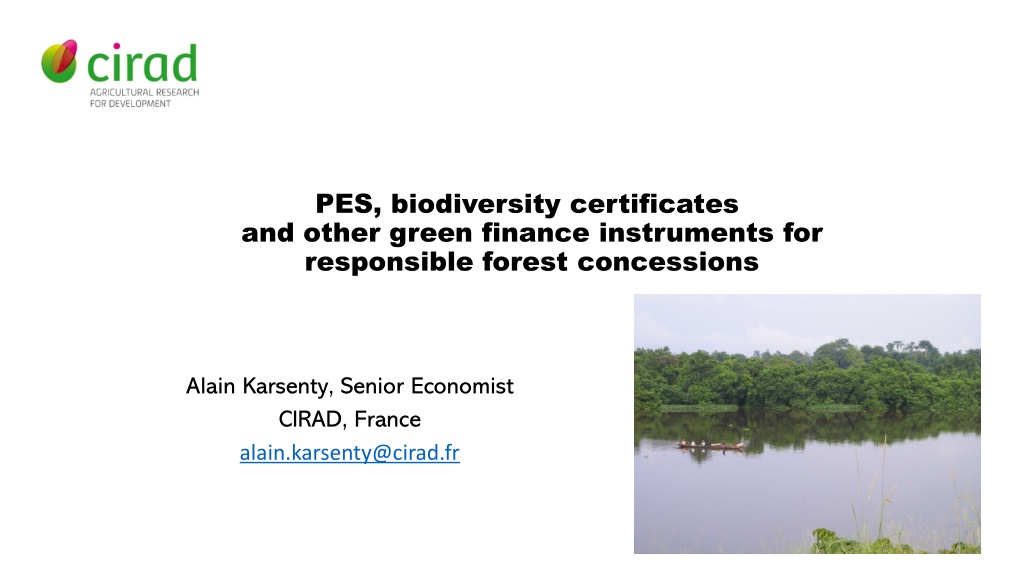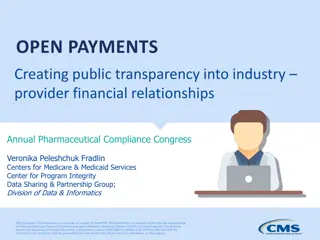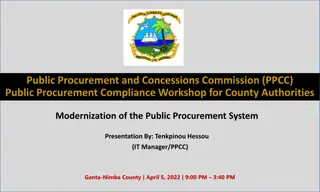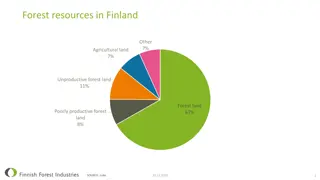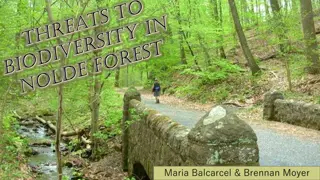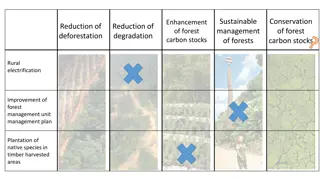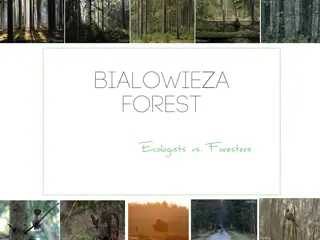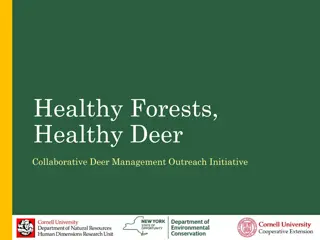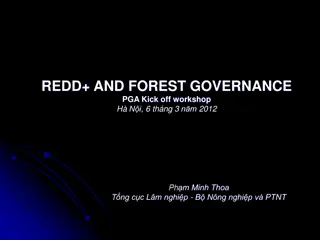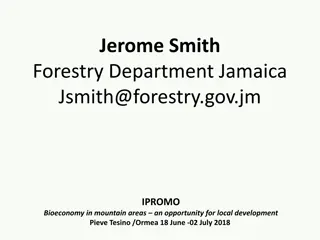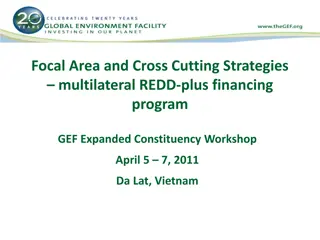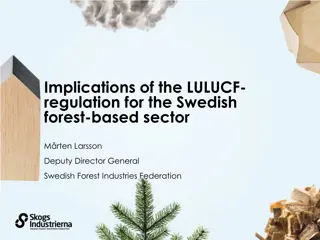Understanding Payments for Environmental Services in Responsible Forest Concessions
Explore the concept of Payments for Environmental Services (PES) in the context of responsible forest concessions. Learn about the distinction between ecosystem services and environmental services, as well as the different types of PES arrangements. Discover how PES can incentivize conservation practices and benefit both nature and society.
Download Presentation

Please find below an Image/Link to download the presentation.
The content on the website is provided AS IS for your information and personal use only. It may not be sold, licensed, or shared on other websites without obtaining consent from the author. Download presentation by click this link. If you encounter any issues during the download, it is possible that the publisher has removed the file from their server.
E N D
Presentation Transcript
PES, biodiversity certificates and other green finance instruments for responsible forest concessions Alain Karsenty, Senior Economist CIRAD, France alain.karsenty@cirad.fr
The MEA framework (2005): Ecosystem services are the benefits people obtain from ecosystems
Regulating Regulating services services: public/collective goods Carbon sequestration service (ecosystem service) enabled by photosynthesis (support service) Natural water filtration service made possible by superposition of clay, limestone and sandy layers Regulation of runoff by plant root system Soil fertilization through activity of micro- organisms and earthworms Pollination service provided by bees and other insects Biological diversity itself can be seen as an ecosystem service that is enabled by changes in organisms
What are Payments for Environmental Services about? A critical distinction to make, between : Ecosystem services: Ecosystem services are the benefits people obtain from ecosystems (MEA, 2005), i.e. services rendered by nature to people Environmental services: actions, practices or management methods that favours conservation or enhancement of ecosystem services
What is paid? PES are not about buying and selling ecosystem services, which are public goods by nature (except provisioning services, which can be appropriated and, thus, have price-making markets). PES are arrangements about remunerating environmental services (practices), often without market procedures Total Economic Valuation exercises are disconnected from PES In Land-Use Restriction PES, payments are bargained around the opportunity cost of the land-user(s) In Asset-Building PES, payments for the worked time (at his opportunity cost), possibly indexed on the species planted, or so.
Environmental Services as practices Ex: the farmer who produces hives, plants a certain type of vegetation and/or gives up pesticides, provides an environmental service, which will enable bees to increase the ecosystem pollination service. Two types of PES: Land-use restriction /conservation PES: agreement on the suspension of some development rights, as long as the agreed payment is made (no transfer of property rights, similar to an easement) Asset-building PES: remuneration of land user s work time for ecosystem restoration and planting on the land they own or control. Can encompass also joint investment for modifying the agro-silvo-pastoral practices (e.g. Vittel)
Forest concessions and carbon-oriented PES On the voluntary carbon market, carbon credits can be sold by concessionaires on the basis of verified emission reductions through activities such as : Longer felling cycle (rotation) in order to reduce harvests (favoring the forest carbon sink) and damages (emission reductions and protection of the carbon sink) Voluntary increase of the minimum diameter of cutting : reduce harvests for enhancing the carbon sink (younger trees growth) and minimize damages Reduced Impact Logging : geolocation of commercial trees, optimized design of skid trails, directional felling Extension of conservation areas within the concession (beyond mandatory requirements of the management plan) Tree plantations on degraded lands beyond legal requirements Valorization of wood wastes through cogeneration (electricity and heat) as a substitution to fossil fuels Further wood processing (less material to be transported from remote areas > fuel and CO2saving)
Carbon crediting conditioned to additionality To qualify as carbon offset, the reductions achieved by a project need to be additional to what would have happened if the project had not been carried out (e.g. continued as business-as-usual). If a project is viable in its own right (through the sale of planted timber, or because of government funding, regulation or other policies), it cannot be used as an offset project In some Congo Basin s countries, as logging is currently not economically profitable (inactive concessions), several concessionaires shift to conservation concessions Such projects unlikely to be additional (concessions would not have been logged over anyway) and will probably not be certified
Non-Permanence: an issue with forestry projects Non-permanence" is a thorny issue: "multiple" residence times for CO2in the atmosphere "from a few months to more than 1000 years" (IPCC, AR-6, WG1, 2021). Fully offsetting CO2emissions would require storing carbon into trees for centuries Forests can burn, be converted and RIL practices dropped In the voluntary carbon market, certification standards requires projects to freeze a certain percentage of carbon credits (up to 30-40%) and put them into a buffer, as a guarantee in case of reversal
Other Other economic economic instruments for instruments for sustainable sustainable forestry forestry Carbon projects are not very numerous in the forestry sector, since the image of natural forests logging is not positive Buyers of carbon credits tend to prefer conservation projects and timber plantations Other incentives can be designed for fostering SFM
Combining fiscal incentives with independent certification
Taxation and feebates (bonus-malus) on externalities If the demand side (price premium) is not enough for scaling up certification numbers, one needs to consider upfront incentives Feebates (or bonus-malus schemes) : an instrument of ecological taxation that combines an increase in taxes on unsustainably produced timber with a decrease in taxes on products deemed sustainable The aim is to achieve budget neutrality by balancing (on an annual basis) tax increases and decreases Feebates should be associated to certifications, whether they are private or public (traceability, adaptation to contexts ) Export taxes are a good lever for implementing feebates but other taxes or lever to be considered (e.g. area tax) Feebates scheme Malus: uncertified products Additional fiscal receipts Bonus: certified products Tax rebates equivalent to the additional receipts 12
Fiscal incentives in Gabon for the forestry sector Fiscal incentives in Gabon for the forestry sector The 2020 policy adopted in Gabon in 2020 identifies three area-based tax rates for forest concessions Previous regime XAF 400/ha/yr New regime Non-certified XAF 800/ha/yr Certification of legality XAF 600/ha/yr Forest management certification (FSC or PAFC) XAF 300/ha/yr 8,000 7,000 6,000 Evolution of certified areas (Forest management or legality) in Congo Basin's countries 5,000 x 1000 ha 4,000 3,000 2,000 1,000 0 13 Cameroon Congo Gabon DRC CAR
The added-value of certification Loopholes in legal frameworks are addressed by FM certification (e.g. Cameroon) FM Certification pushes towards continuous improvement of practices, while legality does not provide incentives to go beyond regulatory thresholds
Certifications as instrument of public Certifications as instrument of public policies policies Initially, FSC certification was associated with an organisation set up for guiding consumers preferences and provides incentives to the best companies Two decades latter, certification has become an institution, that shapes behaviors and matters beyond those who are certified and their clients. Certification is considered in public policies Sarawak: longer terms licenses granted and, now, mandatory for the concessions Congo: new forest law plans to make certification mandatory for concessions Gabon: FSC certification mandatory by 2025?
Contractors Contractors : : heel of many many large the the Achille s Achille s heel of large companies companies Outsourcing to contractors is commonly observed with large companies, but can be an obstacle to certification Allow to reduce costs, by removing large companies obligations to provide social advantages and give high flexibility in case of economic downturn Dilute responsibilities within the production process, especially when remunerations are oriented toward volume delivered rather than quality of work Some institutional arrangements create perverse incentives
Progressive payment for quantities supplied by contractors Progressive payment for quantities supplied by contractors (Indonesia, 1990 s) (Indonesia, 1990 s) $/m3 An incentive for fast harvesting, disregarding wastes and damages (and rotation constraints ) Purchase price of timber to contractors In SE Asia (e.g. Indonesia) the contractors are operating on the concession itself m3/year 5000 6000 7000 8000 0 Quantities supplied by the contractor to the concessionaire
Green bonds A bond is a debt instrument under which the issuer owes the holder a certain amount on which the issuer pays interest. Bonds guarantee a fixed income stream through interest payments and the return of the principal payment at nominal value at maturity. From an investor perspective, the demand for Green Bonds is rooted in the need to demonstrate commitment to environmentally responsible investments.
Forest performance bonds backed by public guarantees Forest Performance Bonds aim to combine the mechanisms of green bonds with the performance- based model of impact bonds. Bond proceeds will be used to provide loans to an underlying portfolio of forest-friendly businesses (deforestation-free agribusiness, clean energy, water, sustainable forest management, etc.). The Green Climate Fund is asked to provide a partial guarantee for the loans.
Toward Toward biodiversity biodiversity certificates certificates? ? Emerging instrument: certificates of positive impact on biodiversity , marketed to companies and financial institutions on an international scale Used for the purpose of making a contribution (to the collective effort to conserve biodiversity) without being offsetting instruments. These impact certificates would serve three purposes: To constitute a monetizable expression of net biodiversity gains (or absence of loss) as a result of an action or project. To be, for the initiators of the projects, a vehicle for providing funding. Serve as support for financing and proof of impact from investors or other institutions wishing to demonstrate a commitment to biodiversity. Ecological restoration of degraded areas Finance anti-poaching programs, fire prevention activities, extension of conservation areas
Thank you for your attention! Back to the trees
